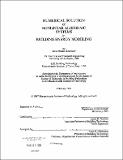| dc.contributor.advisor | Leslie K. Norford. | en_US |
| dc.contributor.author | Lorenzetti, David Michael | en_US |
| dc.date.accessioned | 2005-08-18T18:19:37Z | |
| dc.date.available | 2005-08-18T18:19:37Z | |
| dc.date.copyright | 1997 | en_US |
| dc.date.issued | 1997 | en_US |
| dc.identifier.uri | http://hdl.handle.net/1721.1/10752 | |
| dc.description | Thesis (Ph. D.)--Massachusetts Institute of Technology, Dept. of Architecture and Planning, 1997. | en_US |
| dc.description | Includes bibliographical references (p. 249-251). | en_US |
| dc.description.abstract | When solving a system of nonlinear equations by Newton-Raphson's method, a common means of avoiding divergence requires each step to reduce some vector norm of the residual errors, usually the convenient and tractable sum of squares. Unfortunately, the descent requirement subjects the solver to difficulties typically associated with function minimization-- stagnation, and convergence to local minima. The descent requirement also can disrupt a successful Newton-Raphson sequence. To explore these problems, the thesis reformulates the theory of function minimization in terms of the familiar Jacobian matrix, which linearizes the equations, and a vector which relates first-order changes in the norm to first-order changes in the residuals. The resulting expressions give the norm's gradient, and approximate its Hessian, as functions of the key variables defining the underlying equations. Therefore when Newton- raphson diverges, the solver can choose a reasonable alternate search strategy directly from the Jacobian model, and subsequently construct an appropriate norm for evaluating the search. Applying these results, the thesis modifies a standard equation-solving algorithm, the double dogleg method. Replacing the published algorithm's r-square norm with a general family of weighted r-square norms, it develops and tests a variety of rules for choosing the particular weighting factors. Selecting new weights at each iteration avoids local minima; in tests on a standard suite of nonlinear systems, the resulting algorithms prove more robust to stagnation, and often converge faster, than the double dogleg. In separate investigations, the thesis specializes to equation-solving a double dogleg variation which minimizes the norm model in the plane of its steepest descent and Newton-Raphson directions, and develops a scalar measure of divergence which, unlike a residual norm, does not depend on results from function minimization. | en_US |
| dc.description.statementofresponsibility | by David Michael Lorenzetti. | en_US |
| dc.format.extent | 421 p. | en_US |
| dc.format.extent | 38998477 bytes | |
| dc.format.extent | 38998235 bytes | |
| dc.format.mimetype | application/pdf | |
| dc.format.mimetype | application/pdf | |
| dc.language.iso | eng | en_US |
| dc.publisher | Massachusetts Institute of Technology | en_US |
| dc.rights | M.I.T. theses are protected by copyright. They may be viewed from this source for any purpose, but reproduction or distribution in any format is prohibited without written permission. See provided URL for inquiries about permission. | en_US |
| dc.rights.uri | http://dspace.mit.edu/handle/1721.1/7582 | |
| dc.subject | Architecture | en_US |
| dc.subject | Urban Studies and Planning | en_US |
| dc.title | Numerical solution of nonlinear algebraic systems in building energy modeling | en_US |
| dc.type | Thesis | en_US |
| dc.description.degree | Ph.D. | en_US |
| dc.contributor.department | Massachusetts Institute of Technology. Department of Architecture | |
| dc.contributor.department | Massachusetts Institute of Technology. Department of Urban Studies and Planning | |
| dc.identifier.oclc | 36896733 | en_US |
